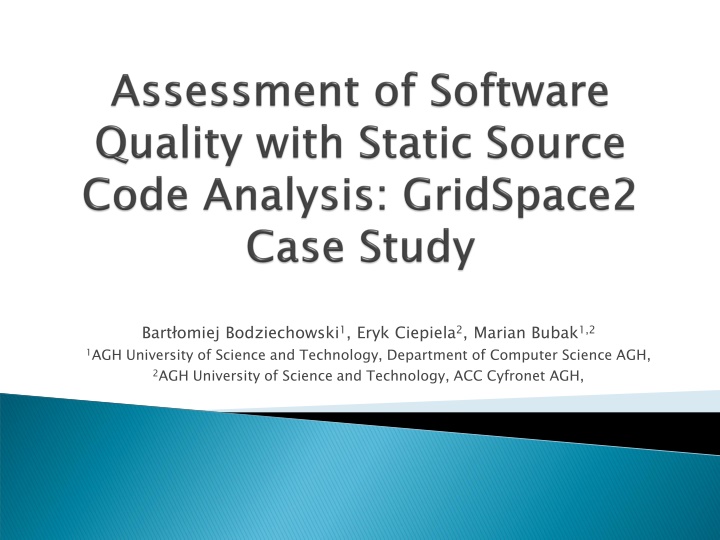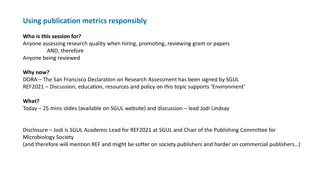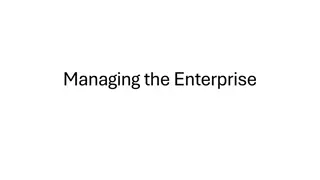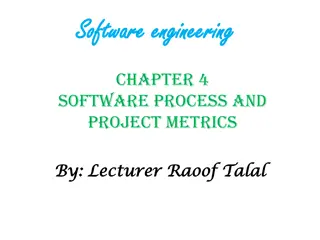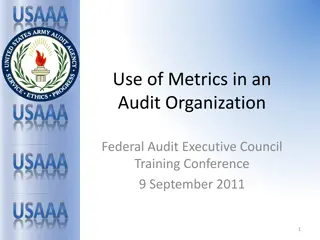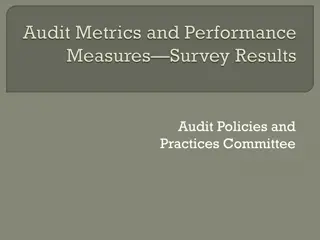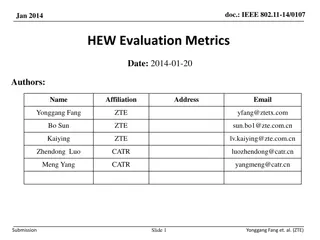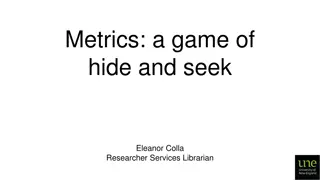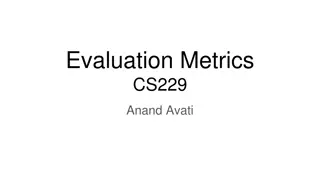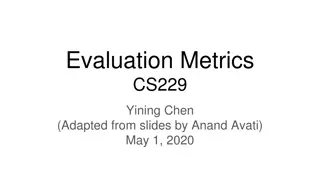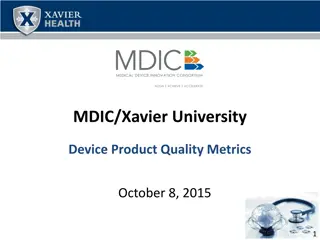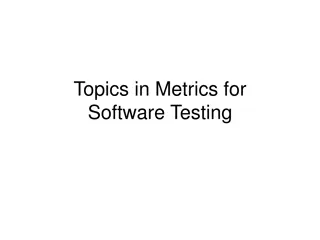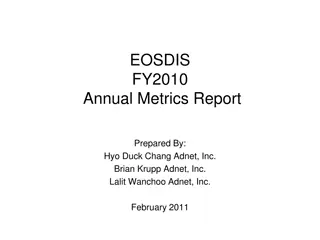Challenges in Software Development and Metrics Analysis
Problems like rigidity, fragility, immobility, and viscosity are common in software development, affecting the system's changeability and robustness. Understanding the importance of static software metrics and their application in assessing software quality and identifying areas for improvement is crucial. This content also discusses the use of metrics in GridSpace2, an in silico experimentation platform, and explores various software engineering principles and practices.
Download Presentation

Please find below an Image/Link to download the presentation.
The content on the website is provided AS IS for your information and personal use only. It may not be sold, licensed, or shared on other websites without obtaining consent from the author.If you encounter any issues during the download, it is possible that the publisher has removed the file from their server.
You are allowed to download the files provided on this website for personal or commercial use, subject to the condition that they are used lawfully. All files are the property of their respective owners.
The content on the website is provided AS IS for your information and personal use only. It may not be sold, licensed, or shared on other websites without obtaining consent from the author.
E N D
Presentation Transcript
Bartomiej Bodziechowski1, Eryk Ciepiela2, Marian Bubak1,2 1AGH University of Science and Technology, Department of Computer Science AGH, 2AGH University of Science and Technology, ACC Cyfronet AGH,
Problems connected with software under development: Rigidity The system is hard to change because every change forces many other changes. Fragility Changes cause the system to break in conceptually unrelated places. Immobility It's hard to disentangle the system into reusable components. Viscosity Doing things right is harder than doing things wrong. Quality of software under development assured by Dynamic analysis - testing Static analysis - metrics Key point: to find relation between metric results and external quality features: functionality, reliability, portability, efficiency, maintainability (ISO 9126). Metric definition: A rule for quantifying some characteristics or attribute of a computer software entity.
Assessment of usefulness of software static metrics in software engineering, Application of software static metrics for GridSpace2 and indication of areas that need to be reviewed and potentially need refactoring, Identifying areas for which static software metrics could be applied for object oriented software, Research and grouping of static software metrics based on available literature and studies Review of open source tools implementing static software metrics for Java programming language.
GS2 is a platform for creating scientific computing application (in silico experiments) with Polish and European data center resources, Developed by Distributed Computing Environments Team working at CYFRONET AGH. Important features of GS2 from metrics point of view : Relatively big projects consist of 400 classes divided into 70 packages, Multilayered application, Developed by the team of programmers, Under constant changes due to the need of adaptation to still changing context and environment of working, Written in Java.
Areas Counts Object- oriented pardigms Laws and principles Artifacts SOLID Law of Demeter Packages Inheritance Single responsibility principle Dependencies Couplings Cohesion Encapsulation Open close principle Reuse/release equivalency principle Acyclic dependency principle Others Liskov substitution principle Polymorphism Stable dependenciy principle Common reuse principle Duplicated code Interface segragation principle Cohesion Common close principle Stable abstractions principle Dependency inversion principle Unit testing covarage Red not covered by metrics
Metrics Size and complexity Duplicates and unit testing covarage Readability, good practice and potential bugs for Java Object oriented metrics Counts of artifacts MOOD (metrics of object- oriented design) by F.Abreu Counts of couplings Chidamber-Kemerer set of metrics R. Martina set of metrics for packages and modules Other laws and principles
Metric definition: A rule for quantifying some characteristics or attribute of a computer software entity. Proposals of metrics in scientific publications and in tools (mainly size and complexity), Verification of metrics: Theoretical understanding the theoretical basis, Practical relationships with external features of software quality, Expected values for the metrics: Resulting from definition, Proposed based on evaluation of software identified as high quality.
Response For a Class Number of methods that can be invoked in response on massage received by object of considered class Typical values: 20-100, review recommended for >200 (L. Rosenberg NASA) To high value means: High internal complexity, To big responsibility set for the class, High cost of testing and maintainability. Coupling Between Objects Number of classes that are connected with considered class in relationships other then inheritance (efferent couplings), The lower the better values, High values means that class is more sensitive for changes in other place of system difficulties with maintainability. Weighted Method per Class Weight of methods is cyclomatic complexity of McCabe a. 60% of classes has WMC [0;20], 36% WMC [20;100], review recommended for >100 (L.R. NASA) Response For a Class Coupling Between Objects Weighted Method per Class
Depth of Inheritance Tree The maximum number of levels of parent classes, High DIT high specialization of class, reducing duplicates, Low DIT weak usage of inheritances and usage of existing packages. Number of Children Is the number of direct descendents of class, Low value again means weak usage of inheritance High value to big responsibility, difficulties in testing Lack of Cohesion Of Methods Indicates lack of cohesion of methods inside the class, It is differences between number of pairs of methods invoking different attributes P and number of pairs of methods invoking at least one common attribute Q : LCOM1 = P - Q , if P > Q LCOM1 = 0 otherwise Depth of Inheritance Tree Number of Children Lack of Cohesion Of Methods
7 tools implementing metrics: Stan: results in the form of histograms, visualization of dependencies on all level of abstractions, RefactorIT: a lot of different metrics, creation of report with precise results for all artifacts useful to carry out self- analysis Sonar: the highest numbers or releases, support for refactoring JDepend, Ckjm, Simian, Cobertura, 3 tools based on rule-set which are checking code for good practice, readability and potential bugs PMD, Checkstyle, Findbugs
Assess the quality of measuring feature for whole system. Histograms are the best to do it. Integrate metrics tools in software development process (Eclipse, Maven plugins) Indicate artifacts with metrics values outside of the recomendations Review of these artifacts Decision about refactoring
Level: m methods, c classes, p packages , s - system
7 different tools were used: Stan, RefactorIT, Sonar, Simian, PMD, Checkstyle, Findbugs. Most important results: Good results obtained for counts metrics of artifacts and couplings (for different metrics only from a few to max 14 classes out of recommended values, Metrics CBO, RFC i WMC results similar like for counts metrics (violations offen for the same classes), Inheritance used mainly by using external packages (high values of DIT and low values for NOC), Classes WMC 136 ew.workbench.client.ui.SnippetPanel 120 sshexecutor.SSHFileManager 118 sshexecutor.ModifiedSCPClient 109 core.execution.ExperimentSessionBase 78 ew.workbench.client.ui.ExperimentPan
Ca. 7% classes needed to be divided to smaller (lack of cohesion) LCOM4>1, Breaking of Stable Abstractions principle , 42% of classes break Law of Demeter, 40% packages involved in cycles braking breaking Acyclic Dependency Principle Law level of duplicates ~5% - good result Unit tests - line covarage 17%
Using software static metrics is useful in keeping high quality of software under development, There are many areas that can be checked by metrics (object-oriented paradigms, laws, principles) but lack of studies for using metrics in the context of design patterns, Values of metrics stay in correlation with external quality features: functionality, reliability, portability, efficiency, maintainability (studies for MOOD and CK set of metrics), Threshold values of metrics set up based on software identified as high quality software or proposal inside tools which roots are not known cautious recommended. Violation of threshold doesn t mean need of refactoring it is only yellow light informing about higher risk of potential failure. Tools based on rules sets (PMD, Checkstyle, Findbugs) needed to be used during code writing, can not be used for audits, Open source tools contains bugs e.g. DIT in Stan, or EP in RefactorIT, Using metrics can help to better understand the software especially its complexity.
Improvement of definitions of existing metrics based on better understanding of theoretical basis, Further studies between metrics violations and problems with external quality features: functionality, reliability, portability, efficiency, maintainability are needed. Studies on using static metrics in context of design pattern. New metrics definitions.
